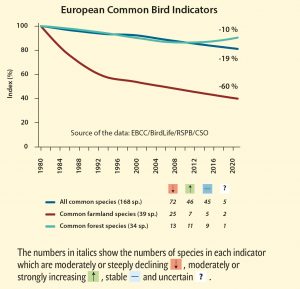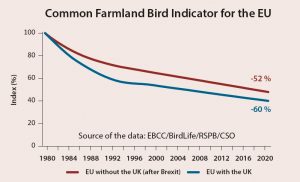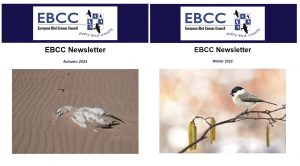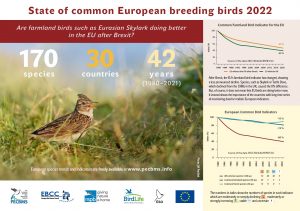Report on the Pan-European Common Bird Monitoring Scheme, February 2023
February 28, 2023
This report summarises the Pan-European Common Bird Monitoring Scheme (PECBMS) activities between 1 September 2022 and 28 February 2023.

In November, PECBMS published the 2022 update of European species trends and indicators. We promoted the trends of individual species via social media. Photo of the Common Woodpigeon by Zbyněk Nantl https://eu.zonerama.com/zbyneknantl/631847
Summary
We released the 2022 update of supra-national European species trends and indicators on 23 November. Almost all countries could deliver their data up to 2021, which is an important step forward for the PECBMS to produce the most up-to-date outputs possible. The 2022 update covers 42 years from 30 countries, including Andorra, for the first time, thus covering 26 EU MS – all but Malta, with no regular bird monitoring scheme. We updated the network with regular newsletters and web articles and published the leaflet. Moreover, we spread a questionnaire among the national coordinators to update the information on their schemes and national farmland bird indicators produced so far, including the species lists behind them. In addition, we met EU stakeholders, researchers and coordinators regularly and provided answers and advice upon request. In February, we organised the third webinar for coordinators. Finally, we attended four conferences and workshops, either online or in-person, plus the EBCC Board meetings and presented the progress of the PECBMS.
Project funding
The project is funded by the EC tender called “Technical and scientific support in relation to the delivery and development of wild bird indicators for the EU” by the end of April 2023. Unfortunately, afterwards, the routine PECBMS activities remain unsecured despite our efforts.
Production of European species trends and indices
On 23 November 2022, we published trends and indices of 170 common European bird species for 1980–2021 based on data from 30 countries. The outputs were computed for an extended period (1980–2021) and the last ten years (2012–2021). A new country, Andorra, joined the PECBMS. In most countries, delays in data delivery shrank from two years to one year. Therefore, we shortened the delay in producing supra-national outputs and used data till 2021 (instead of 2020). The only exceptions were Germany and Portugal, which provided data up to 2020. At the same time, we published the European Common Bird Indicators 2022 update based on data from 30 countries (1980–2021). All supranational outputs are freely available to download at the PECBMS website.

Fig. 1 European Common Bird Indicators (1980–2021). All common species (168), shown in the blue line, declined by 19%; common forest species (34), in the green line, declined by 10%; and common farmland species (39), in the red line, declined by 60%.
2022 was the first time we dealt with Brexit since we calculated and published the PECBMS data update until 2021. We decided to follow the EUROSTAT attitude. Eurostat’s policy is that (1) the ‘EU aggregate’ is the aggregate of data for countries that are members of the EU at the time the data are published (not in the year the data refer to); and (2) time series must be consistent in terms of concepts, scope and definitions.

Fig. 2 EU Common Farmland Bird Indicator (1980–2021). The red line shows the index based on the dataset excluding the UK data (52% decline); the yellow line shows the index based on the dataset including the UK data (60% decline).
Technical improvements
We successfully started to use RTRIM-shell instead of the old program Birdstats. Finally, 26 coordinators out of 30 delivered RTRIM-shell outputs in the 2022 update. Therefore, we expect all the national coordinators to deliver RTRIM-shell outputs next.
We have regularly updated RTRIM-shell scripts, and each coordinator could contribute with their improvements. The PECBMS coordinator gathers these changes and then releases new versions of the R scripts. The latest version is published via the PECBMS Slack forum and on our web so the whole community can use and acquire this knowledge.
In the 2022 update, we used new population sizes from the European Red List of the Birds (2021) and modified RSWAN for new countries joining PECBMS. We also modified the RSWAN outputs so we could use an online tool for their assessment.
Malta is the last EU member state not covered by PECBMS so far. Therefore, we started cooperation with BirdLife Malta to support establishing a regular common bird monitoring scheme in the country. The breeding season 2023 will be a pilot one.
Site-level data and online tool
we also revised the PECBMS site-level database, which consists of annual bird abundances at georeferenced census sites from 39 monitoring schemes (30 European countries). It contains information from 30,790 locations and 451 species. In addition, we conducted data quality controls, including checking and fixing data for taxonomical inconsistencies. The update of the site-level data has been performed in parallel with the development of the site-level data online tool, which allows more efficient data checks and management and communication with national coordinators.
During the given period, we have updated the site-level data sets until 2019–2021 for Croatia, Ireland, Latvia, Lithuania, and Slovakia, including all species recorded in the sites.
Presentation of results and promotion
We informed the national coordinators and the wider audience, comprising 660 contacts, on the progress of the PECBMS via reports in the quarterly electronic EBCC Newsletter (Autumn and Winter issues 2022). All issues are available online on the pecbms.info website.

Fig. 3 Title pages of the EBCC e-newsletter.
PECBMS website www.pecbms.info has been actualised regularly. In the given period, we published six news, updated the list of publications, PECBMS methods, and information on the European bird monitoring schemes and national indicators based on a survey we conducted in October 2022.
To address the wider public, we maintained the Facebook and Twitter profiles and updated the posts regularly every week – 28 news from 1 September 2022 until 28 February 2023.
The PECBMS concise leaflet was released on 5 December 2022 and promoted via EBCC Facebook and newsletter. It summarises the 2022 Trends and Indicators update outputs, including the list of all 170 species, the classification of their trends, the graph of the three main indicators and a graph comparing the EU Farmland Bird Indicator with and without the UK. The leaflet is freely downloadable from the website pecbms.info/2022-update-leaflet-published. The leaflet was printed in 3000 copies, and at the beginning of December 2022, 2700 were distributed to national coordinators, researchers and project stakeholders by post (300 copies are stored for in-person distribution).

Fig. 4 Title page of the PECBMS 2022 leaflet. Photo of the Skylark by Jiří Parůžek www.jiri-paruzek-foto.cz
Research
The PECBMS data has been used in a number of studies. E.g., site-level data on 50 farmland birds has been involved in the pilot EBBA2 Live project attempting to update EBBA2 maps of farmland birds (period 2013–2017) with maps based on PECBMS data (2018–2023). In a case study led by JRC, site-level data were used to explore farmland bird trends in different farming systems and reveal linkage to agricultural intensification.
In December, we delivered the final report to the EC on the Exploration of the association of the European bird species with the EUNIS habitats categories (level II). The study’s outputs highlight the potential of the PECBMS site-level data to expand European wild bird indicators to other habitats using more species.
The PECBMS team represented EBCC at several conferences, workshops and meetings. During 23–25 September 2023, there was a CSO conference in Mikulov, Czechia, where we gave the following talks:
Gamero A.: Quantifying species habitat associations and habitat trends for European birds
Klvaňová A., Šilarová E., Gamero A., Škorpilová J., Rivas Salvador J., Voříšek P.: Co jsme se dozvěděli díky dlouhodobému sčítání běžných druhů ptáků v Evropě? (What have we learned from the long-term census of common bird species in Europe?)
Šilarová E. and Škorpilová J.: Vliv JPSP a LSD na ochranu přírody v Evropě (The impact of JPSP and LSD on nature conservation in Europe)
Alena Klvaňová attended the Conference on Nature Restoration Law in Prague, 12–13 October 2022 and presented a talk: How should monitoring contribute to ensuring the quality of nature restoration? In: Panel 3 – Implementation of the NRL.
On 8 November 2022, Alena Klvaňová was invited to present PECBMS at the EUROPABON and Biodiversa+ conference in Brussels, Belgium Shaping the future European biodiversity monitoring Framework, and gave a talk called The Pan-European Common Bird Monitoring Scheme – an NGO perspective on biodiversity monitoring.
On 21 February 2023, Alena Klvaňová attended an expert meeting (online) held in Copenhagen Biodiversity data flows and data infrastructure. She joined the Plenary session to review key biodiversity data flow components and talked about Citizen science data.
In February, we updated the continent-wide population size changes “Long-term and large-scale multispecies dataset tracking population changes of common European breeding birds” in the Zenodo repository, supplementing the data paper published in 2020.
Maintain and update the network of cooperating organisations and individuals
We provided advice and consultations to the national coordinators upon request as in following exapmples:
Greece: we are in touch to support the scheme and help raise funding.
Slovakia: we discussed the details of the recently established monitoring scheme in the country and how to combine the data.
Malta: we met BirdLife Malta colleagues to discuss the pilot year of bird monitoring in Malta and the possibilities of joining the PECBMS.
Slovenia and Croatia: we discussed the newly established schemes dedicated to forest birds to produce national forest bird indicators.
Moldova: in cooperation with CSO, we asked Czech CSO members to donate old binoculars to support the fieldworkers in the Moldavian commencing scheme.
On 10 February, we organised the third PECBMS webinar (via Zoom) dedicated to the RTRIM shell and related topics. Eva Šilarová guided the national coordinators from the data preparation to data validation in the online tool. Moreover, Anna Gamero introduced the new site-level data online tool accessible to all the coordinators. Altogether, 31 participants, mainly national coordinators, attended the event.
Active communication with EU stakeholders
On 7 November 2022, we visited DG ENV in Brussels to discuss the Service Contract outputs and future cooperation.
In November 2022, we arranged an online meeting with EUROSTAT and introduced the PECBMS project and indicators production.
Reporting to the EBCC Board
We regularly attended EBCC Board meetings on 8 November and 15 February. We presented the PECBMS progress and main outputs for the given periods.

Fig. 5 EBCC Interim Board Meeting, conducted online on 15 February. Photo by Dawn Balmer